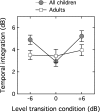Monaural temporal integration and temporally selective listening in children and adults
- PMID: 20550263
- PMCID: PMC2896408
- DOI: 10.1121/1.3397464
Monaural temporal integration and temporally selective listening in children and adults
Abstract
This study used two paradigms to investigate the development of temporal integration and temporally selective listening. Experiment 1 measured detection as a function of duration for a pure tone at 1625 or 6500 Hz. At both frequencies thresholds of children younger than 7 years old were higher than those for older children and adults. The pattern of temporal integration was similar across groups for the 6500-Hz signal, but younger children showed relatively more temporal integration for the 1625-Hz signal due to high thresholds for the briefest 1625-Hz signal. Experiment 2 measured detection thresholds for one or for three brief tone pips presented in a noise masker. In one set of conditions, the noise masker consisted of 100-ms steady bursts interleaved with 10-ms temporal gaps. In other conditions, the level of the central 50 ms of the 100-ms masking noise bursts was adjusted by either +6 or -6 dB. Children showed higher thresholds but similar temporal integration compared with adults. Overall, these data suggest that children are less efficient than adults in weighting the output of the monaural temporal window at 1625 but not 6500 Hz. Children are efficient in combining energy from brief temporal epochs that are separated by noise.
Figures





Similar articles
-
The monaural temporal window based on masking period pattern data in school-aged children and adults.J Acoust Soc Am. 2013 Mar;133(3):1586-97. doi: 10.1121/1.4788983. J Acoust Soc Am. 2013. PMID: 23464028 Free PMC article.
-
Effects of non-simultaneous masking on the binaural masking level difference.J Acoust Soc Am. 2011 Feb;129(2):907-19. doi: 10.1121/1.3514528. J Acoust Soc Am. 2011. PMID: 21361448 Free PMC article.
-
Effect of signal-temporal uncertainty in children and adults: tone detection in noise or a random-frequency masker.J Acoust Soc Am. 2013 Dec;134(6):4446. doi: 10.1121/1.4828828. J Acoust Soc Am. 2013. PMID: 25669256 Free PMC article.
-
Electrophysiological and psychophysical asymmetries in sensitivity to interaural correlation gaps and implications for binaural integration time.Hear Res. 2016 Feb;332:170-187. doi: 10.1016/j.heares.2015.10.012. Epub 2015 Oct 23. Hear Res. 2016. PMID: 26526276
-
Off-frequency BMLD: the role of monaural processing.Adv Exp Med Biol. 2013;787:293-301. doi: 10.1007/978-1-4614-1590-9_33. Adv Exp Med Biol. 2013. PMID: 23716235
Cited by
-
Late maturation of backward masking in auditory cortex.J Neurophysiol. 2018 Oct 1;120(4):1558-1571. doi: 10.1152/jn.00114.2018. Epub 2018 Jul 11. J Neurophysiol. 2018. PMID: 29995598 Free PMC article.
-
Effects of Self-Generated Noise on Quiet Threshold by Transducer Type in School-Age Children and Adults.J Speech Lang Hear Res. 2020 Jun 22;63(6):2027-2033. doi: 10.1044/2020_JSLHR-19-00302. Epub 2020 May 27. J Speech Lang Hear Res. 2020. PMID: 32459139 Free PMC article.
-
Effects of Self-Generated Noise on Estimates of Detection Threshold in Quiet for School-Age Children and Adults.Ear Hear. 2016 Nov/Dec;37(6):650-659. doi: 10.1097/AUD.0000000000000337. Ear Hear. 2016. PMID: 27438873 Free PMC article.
-
Factors affecting the processing of intensity in school-aged children.J Speech Lang Hear Res. 2013 Feb;56(1):71-80. doi: 10.1044/1092-4388(2012/12-0008). Epub 2012 Aug 15. J Speech Lang Hear Res. 2013. PMID: 22896044 Free PMC article.
-
The monaural temporal window based on masking period pattern data in school-aged children and adults.J Acoust Soc Am. 2013 Mar;133(3):1586-97. doi: 10.1121/1.4788983. J Acoust Soc Am. 2013. PMID: 23464028 Free PMC article.
References
-
- ANSI (2004). “Specification for audiometers,” ANSI S3.6-2004, American National Standards Institute, New York.
-
- Barry, S. J., and Larson, V. D. (1974). “Brief-tone audiometry with normal and deaf school-age children,” J. Speech Hear. Res. JSPHAH 39, 457–464.
-
- Berg, K. M. (1991). “Auditory temporal summation in infants and adults: Effects of stimulus bandwidth and masking noise,” Percept. Psychophys. PEPSBJ 50, 314–320. - PubMed
-
- Berg, K. M., and Boswell, A. E. (1995). “Temporal summation of 500-Hz tones and octave-band noise bursts in infants and adults,” Percept. Psychophys. PEPSBJ 57, 183–189. - PubMed
Publication types
MeSH terms
Grants and funding
LinkOut - more resources
Full Text Sources
Miscellaneous

